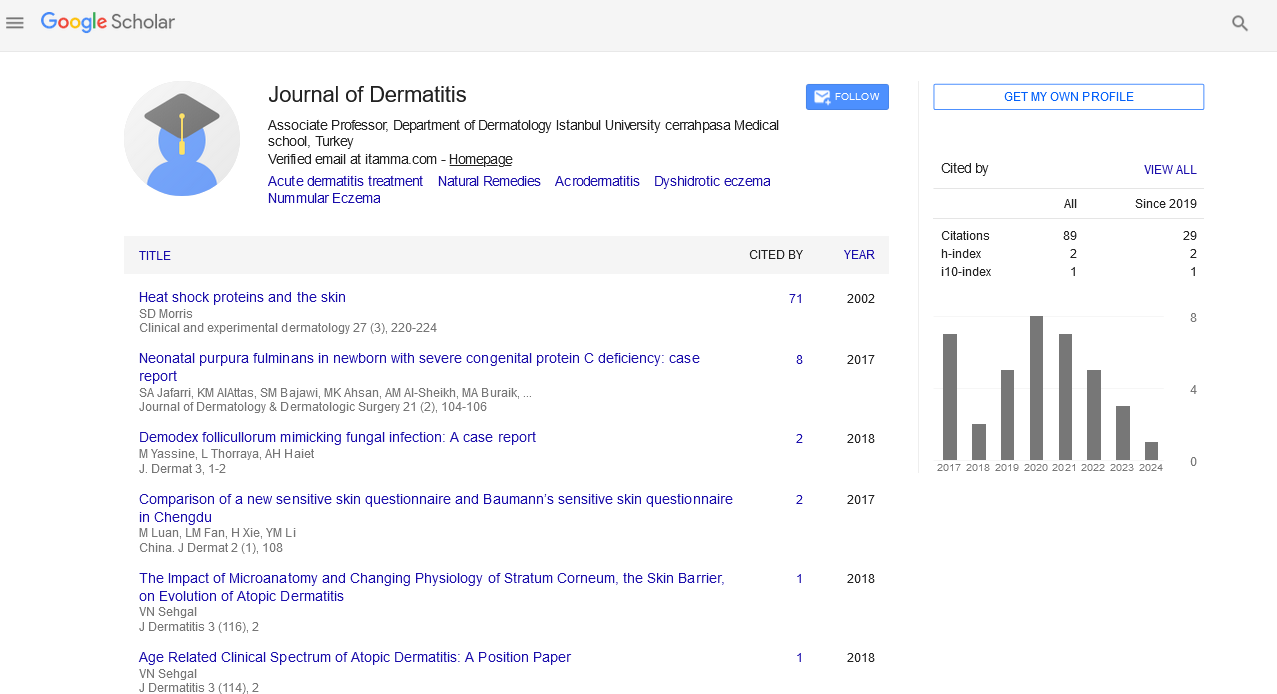Indexed In
- RefSeek
- Hamdard University
- EBSCO A-Z
- Euro Pub
- Google Scholar
Useful Links
Share This Page
Journal Flyer

Open Access Journals
- Agri and Aquaculture
- Biochemistry
- Bioinformatics & Systems Biology
- Business & Management
- Chemistry
- Clinical Sciences
- Engineering
- Food & Nutrition
- General Science
- Genetics & Molecular Biology
- Immunology & Microbiology
- Medical Sciences
- Neuroscience & Psychology
- Nursing & Health Care
- Pharmaceutical Sciences
Commentary - (2022) Volume 7, Issue 2
Overview of Static Dermatitis
Craig Burkhart*Received: 01-Mar-2022, Manuscript No. JOD-22-16438; Editor assigned: 04-Mar-2022, Pre QC No. JOD-22-16438 (PQ); Reviewed: 17-Mar-2022, QC No. JOD-22-16438; Revised: 24-Mar-2022, Manuscript No. JOD-22-16438 (R); Published: 31-Mar-2022, DOI: 10.35248/2684.1436.22.7.149
Description
Stasis dermatitis, also known as gravitational dermatitis, venous eczema, and stasis dermatitis, occurs when there is venous insufficiency or poor blood flow to the lower extremities.
Venous insufficiency occurs when the venous valves in the legs help push blood back into the heart, weakening and leaking fluid. This causes water and blood cells to accumulate in the lower extremities. Venous insufficiency may be associated with aging, but it may also indicate a serious underlying disorder such as heart disease or kidney disease.
Symptoms
Stasis dermatitis can affect one or both legs or lower limbs. It may appear in other parts of the body, but this is rare. In addition to ankle swelling, early signs include an orange-brown discoloration, sometimes referred to as cayenne pepper spots. These spots form when the smallest blood vessels, the capillaries, rupture from pressure and swelling. Other symptoms of stasis dermatitis are:
• Redness of light skin tones. Dark skin tones may appear brown, purple, gray.
• Itching
• Scaling
• Dry
• Heavy or painful sensations after sitting or standing for extended periods of time
• Increased risk of developing contact dermatitis
If left untreated, stasis dermatitis can cause swelling to spread from the ankles to the calves and make the skin shiny. An open wound called a venous ulcer can form on the lower extremities and instep. These ulcers can leave bleeding, exudation, and scarring when healed. Severe stasis dermatitis can cause permanent skin changes, including a thickening, hardening, darkening, or uneven cobblestone-like appearance.
Causes
Stasis dermatitis tends to occur in people with poor blood circulation in the legs, such as: Chronic venous insufficiency. This happens when high blood pressure occurs due to a venous obstruction or a defective valve. This causes inflammation and can cause skin changes such as ulcers. For example, in the case of chronic venous insufficiency, the valves in the lower extremity veins do not function properly. This causes blood to flow back and collect in the lower limbs. This accumulation increases the pressure and swelling of the veins and the symptoms of stasis dermatitis.
Diagnosis
Doctors diagnose stasis dermatitis by asking about the person's symptoms and medical history. Here are some past or present situations you should be aware:
• Heart or circulatory problems
• Blood clot
• Operation
• Lower leg injury
The doctor may then examine the skin on the lower extremities to look for visual signs of stasis dermatitis. You can also order Doppler ultrasound, a non-invasive test that uses sound waves to check blood flow through blood vessels. These tests help identify the underlying reason for stasis dermatitis.
Here are some additional tests to look for the root cause:
• Echocardiography for assessing cardiac function, including checking for congestive heart failure
• Blood pressure monitoring
• In some cases allergy test
Other conditions with similar symptoms include reliable sources:
• Cellulite
• Contact dermatitis
• Pigmented purpura, a group of skin disorders with bleeding from capillaries.
Treatment
The purpose of the treatment of tonic dermatitis is to improve the circulation before proceeding and reduce the condition of preventing the condition. Treatment may include:
• To enhance the compression stockings to facilitate circulation and mitigate swelling
• Wear a type compression association called Unna boots, including calamine and other medicines to heal the wound
• Sleep with elevated legs
• Move the legs once 2 hours
• Drink medicine to ease pain and reduce swelling like topical corticosteroids
• Use antihistamine drugs to calm down
• Use of antibiotics and special associations to treat infected ulcers
• Apply Emollients to wet and protect skin
• Intake of vitamin C and rutin supplements to enhance blood vessel health
In some cases, the doctor can recommend the minimally invasive procedure of the source:
• Sun Accumulation, Type One Laser Therapy
• Ultrasonic-induced foam curing therapy that destroys unwanted veins by injecting the combination of air and a special foam solution
• Surgical surgery for retracted sources under phlebotomy, local anesthetic
These are the treatment of varicose veins that can be used to treat fundamental problems leading to tonic dermatitis.
Citation: Burkhart C (2022) Overview of Static Dermatitis. J Dermatitis.7:149
Copyright: © 2022 Burkhart C. This is an open-access article distributed under the terms of the creative commons attribution license which permits unrestricted use, distribution and reproduction in any medium, provided the original author and source are credited.

